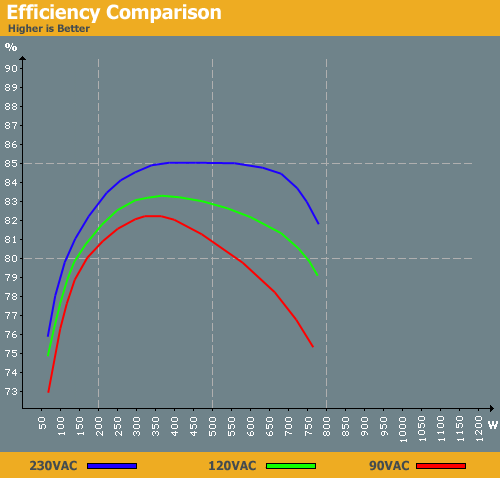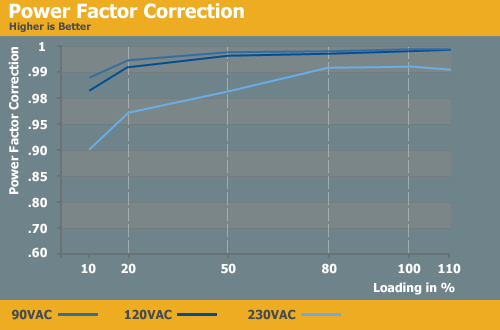Silverstone Decathlon DA700 Super Silent Power Supply
by Christoph Katzer on April 22, 2008 12:00 AM EST- Posted in
- Cases/Cooling/PSUs
Efficiency and PFC


The efficiency didn't get above 85%, which is strange as we expected a little more than that. However, we don't want to make a big deal out of it since 85% is a very good result, even if it's common with today's high-end power supplies. The good thing is that the efficiency stays high for a long period under 230VAC, but as the graph also shows you need to pull at least 200W to reach 83% or higher efficiency. The DA700 also works well from 250 to 650W with a minimum input voltage of 120VAC. With 90VAC this power supply doesn't work as well, peaking at82% and 350W and staying above 80% for about half of the rated output range.

The power factor correction once again performs best with lower input voltages. People in Europe might need to accept much lower grades, though the results here are normal for an active PFC unit.










20 Comments
View All Comments
Stefan555 - Tuesday, April 22, 2008 - link
Yes Chris, the physical layout of the PCB show there are four rails. It doesnt mean each rail has a limiter. Whitout limiters = SINGLE rail unit.Kanchenjunga - Tuesday, April 22, 2008 - link
You'd think that somebody who just reviewed the single 12V rail Impervio made EliteXStreams with 5 rails printed on the PCB and color coded wires would have this figured out by now. How come you guys don't do the OCP test that your testing method article talks about?Christoph Katzer - Tuesday, April 22, 2008 - link
I guess that sentence where I mention the four rails has been just misleading as I didnt mean to say it's a four 12V rail PSU. I will change that for the sake of a good sleep tonight :)MrOblivious - Tuesday, April 22, 2008 - link
What was the OCP set at for each of the 4 12v rails?Stefan555 - Tuesday, April 22, 2008 - link
"The rail specification is rather obfuscated, requiring several perusals and the use of a calculator before you actually understand what you're reading."It's simple, what we are reading is the label, the label tells you it has an capability to put out 58A on one single rail on +12V (no matter the reality one or four rails). It also tells you the psu has the capability to put out 180W or combined on +3.3 and +5V. I can't see what is so obfuscated?
"The DA700 comes with a single 12V rail rated for up to 58A which is almost 700W already. Obviously, that load is not possible with the combined power of all three main rails; doing the necessary math, if you put a load of 180W on the 3.3V and 5V rails, that leaves 520W for the 12V rail, or 43A."
On which psu can you take the maximum combined output on +3.3V and +5V and add it with the maximum capability on +12V and get anywhere near the total specified wattage on the psu? None.
There is no psu where you can draw the maximum output on +3.3V and +5V combined and +12V at the same time.
This unit is not the only psu where the combined output on +12V is so high its more a theoretical maximum output. Other units has even less left for +3.3V and +5V. But that is pure theory.
If now the unit has four rails on +12V, well that is a bit of lame of Silvertone not to tell it. I agree. But still, it has nothing to do with the readability of the label. Besides it is mentioned later in the review.
Calin - Tuesday, April 22, 2008 - link
"The problem is that there are quite a lot of patents on larger fans"How the hell could a larger fan be patented? What kind of backward country is that?
Christoph Katzer - Tuesday, April 22, 2008 - link
The patent is a power supply cooled by a 140mm fan. That's why other manufacturers (other than CWT the patent owner) need to make use of 135mm or 120mm fans. In the U.S you get patents for all kinds of stuff...masher2 - Tuesday, April 22, 2008 - link
Sounds like an urban myth to me..MrOblivious - Tuesday, April 22, 2008 - link
SuperFlower has been using 140mm fan's for years, indeed IIRC before CWT.strikeback03 - Tuesday, April 22, 2008 - link
Time for someone to make a 141mm fan